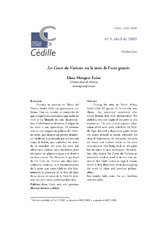Les Caves du Vatican, ou la sotie de l’acte gratuit
Autor
Meseguer Paños, Elena
Editor
UCOPressFecha
2009Materia
Gide, André, 1869-1951Sotie
Acto gratuito
Libertad
Intertextualidad
Free act
Freedom
Intertextuality
METS:
Mostrar el registro METSPREMIS:
Mostrar el registro PREMISMetadatos
Mostrar el registro completo del ítemResumen
Durante su estancia en África del
Norte, André Gide cae gravemente enfermo.
Una vez curado, es consciente de
que la experiencia existencial que acaba de
vivir lo ha liberado de todo determinismo.
Probablemente debamos el origen de
las soties a este aprendizaje. El término
sotie es una adaptación gidiana del término
sottie, que designa un género dramático
medieval, interpretado por actores con
trajes de bufón, que criticaban los vicios
de su sociedad. Así pues, las soties son
obras tanto clásicas como modernas, pues
recuperan un género antiguo y se abren a
técnicas nuevas. No obstante, lo que hace
de Les Caves du Vatican una obra esencialmente
moderna, es el replanteamiento
de la razón que opera Gide en ella. Examinando
la presencia en la obra de ideas
de su época así como de la filosofía anterior,
es como mejor podremos ilustrarlo. During his time in North Africa,
André Gide fell gravely ill. It was this very
illness, this existential experience that
would liberate him from determinism. We
probably owe the origin of the soties to this
experience. The term sotie is a gidean adaptation
of the term sottie, which in the Middle
Ages denoted a dramatical genre where
the actors dressed as jesters criticised the
vices of their society. In this sense, the soties
are classic and modern works at the same
time, because they bring back an old genre
but are open to new techniques. Nevertheless,
what makes Les Caves du Vatican an
essentially modern work is in the new approach
that Gide makes to logical reason,
which is best illustrated when investigating
the work of ideas and previous philosophies.

